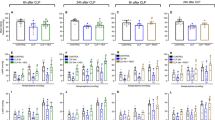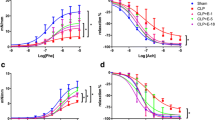Abstract
A stellate ganglion block (SGB) is a clinical sympathetic block which can inhibit the body systemic inflammatory response. However, whether and how SGB can attenuate the sepsis-induced acute lung injury remains unclear. Here, we evaluated the effect of SGB on sepsis-induced acute lung injury in rats. Ninety healthy Sprague Dawley (SD) male rats were divided into three groups: the sham operation group (S group), sepsis group (Sep group), and SGB group. The sepsis model rats were produced by cecum ligation and puncture (CLP), and blood samples were taken from the abdominal aorta of the rats at different time points for evaluating the concentration of TNF-α, IL-6, and IL-10 by enzyme-linked immunosorbent assay (ELISA). The rats were sacrificed, and lungs were collected to measure the wet/dry (W/D) lung tissue weight ratio, score the lung tissue pathological damage by microscopic examination, determine the myeloperoxidase (MPO) activity by spectrophotometry, and measure nuclear factor-kappa B (NF-κB) p65 expression by Western blot. The concentration of serum TNF-α, IL-6, and IL-10, lung tissue W/D ratio, pathological injury score, MPO activity, and expression of NF-κB p65 were higher in the Sep group compared with the S group at T1–4. Furthermore, the concentration of serum TNF-α and IL-6, lung tissue W/D ratio, pathological damage score, MPO activity, and expression of NF-κB p65 were reduced and the concentration of IL-10 was increased in the SGB group compared with the Sep group at T1–4. The successful sepsis model rats were induced by CLP, and SGB attenuated the sepsis-induced acute lung injury in rats.






Similar content being viewed by others
References
Hennessy, E., C. Adams, F.J. Reen, and F. Is O'Gara. 2016. There potential for repurposing statins as novel antimicrobials? Antimicrobial Agents and Chemotherapy 60 (9): 5111–5121.
Sevransky, J.E., G.S. Martin, C. Shanholtz, et al. 2009. Mortality in sepsis versus non-sepsis induced acute lung injury. Critical Care 13 (5): 1.
Lange, M., Y. Nakano, D.L. Traber, A. Hamahata, A. Esechie, C. Jonkam, K. Bansal, L.D. Traber, and P. Enkhbaatar. 2010. Role of different nitric oxide synthase isoforms in a murine model of acute lung injury and sepsis. Biochemical and Biophysical Research Communications 399 (2): 286–291.
Dulloo, A.G., and J.P. Montani. 2012. Body composition, inflammation and thermogenesis in pathways to obesity and the metabolic syndrome: an overview. Obesity Reviews 13 (S2): 1–5.
Hadjiminas, D.J., K.M. McMasters, J.C. Peyton, M.D. Cook, and W.G. Cheadle. 1994. Passive immunization against tumor necrosis factor and interleukin-1 fails to reduce lung neutrophil sequestration in chronic sepsis. Shock 2 (5): 376–380.
Bai, J., L. Tang, J. Lomasneira, et al. 2015. TAT-SNAP-23 treatment inhibits the priming of neutrophil functions contributing to shock and/or sepsis-induced extra-pulmonary acute lung injury. Innate Immunity 21 (1): 42–54.
Dan, H., X. Yang, Y. Xiang, et al. 2015. Inhibition of Toll-like receptor 9 attenuates sepsis-induced mortality through suppressing excessive inflammatory response. Cellular Immunology 295 (2): 92–98.
Toklu, H.Z., T.T. Akbay, A. Velioglu-Ogunc, et al. 2008. Silymarin, the antioxidant component of Silybum marianum, prevents sepsis-induced acute lung and brain injury. Journal of Surgical Research 145 (2): 214–222.
Hynninen, M., V. Pettilä, O. Takkunen, R. Orko, S.E. Jansson, P. Kuusela, R. Renkonen, and M. Valtonen. 2003. Predictive value of monocyte histocompatibility leukocyte antigen-DR expression and plasma interleukin-4 and -10 levels in critically ill patients with sepsis. Shock 20 (1): 1–4.
Chen, X., Y. Wang, H. Luo, et al. 2013. Ulinastatin reduces urinary sepsis-related inflammation by upregulating IL-10 and downregulating TNF-α levels. Molecular Medicine Reports 8 (1): 29–34.
Liu, G.-D., and C.-J. He. 2014. Stellate ganglion block promotes recovery of Bell’s palsy in patients with diabetes mellitus. Acta Oto-Laryngologica 134 (6): 652–655.
Noma, N., H. Kamo, Y. Nakaya, K. Dezawa, A. Young, J. Khan, and Y. Imamura. 2013. Stellate ganglion block as an early intervention in sympathetically maintained headache and orofacial pain caused by temporal arteritis. Pain Medicine 14 (3): 392–397.
Liu, M.H., J. Tian, Y.P. Su, T. Wang, Q. Xiang, and L. Wen. 2013. Cervical sympathetic block regulates early systemic inflammatory response in severe trauma patients. Medical Science Monitor International Medical Journal of Experimental & Clinical Research 19: 194–201.
Liu, M.-H., J. Tian, Y.-P. Su, T. Wang, Q. Xiang, and L. Wen. 2013. Cervical sympathetic block regulates early systemic inflammatory response in severe trauma patients. Medical Science Monitor: International Medical Journal of Experimental and Clinical Research 19: 194.
Cui, Y., L. Wang, Z. Tian, Z. Lin, and D. Chen. 2013. The effect of rhubarb pre-treatment on intestinal microcirculation in septic rats. American Journal of Chinese Medicine 42 (5): 1215–1227.
Ikeda, T., H. Hirakawa, T. Kemuriyama, Y. Nishida, and T. Kazama. 2009. Effect of cervical sympathetic trunk transection on renal sympathetic nerve activity in rats. Physiological Research 58 (1): 77–82.
Liu, M.H., J. Tian, Y.P. Su, T. Wang, Q. Xiang, and L. Wen. 2012. Cervical sympathetic block regulates early systemic inflammatory response in severe trauma patients. Medical Science Monitor International Medical Journal of Experimental & Clinical Research 19: 194–201.
Ghosh, S., and M.S. Hayden. 2008. New regulators of NF-κB in inflammation. Nature Reviews Immunology 8 (11): 837–848.
Li, Z., S. Jin, C. Wang, R. Jiang, and J. Wan. 2010. Histone deacetylase inhibitors attenuate acute lung injury during cecal ligation and puncture-induced polymicrobial sepsis. World Journal of Surgery 34 (7): 1676–1683.
Wang, Y.-H., T.-H. Li, B.-Q. Wu, H. Liu, Y.-F. Shi, and D.-Y. Feng. 2015. Protective effects of caffeoylxanthiazonoside isolated from fruits of Xanthium strumarium on sepsis mice. Pharmaceutical Biology 53 (9): 1367–1371.
Iwama, H. 1997. Can superior cervical ganglionectomy be an experimental model of stellate ganglion block? Masui the Japanese Journal of Anesthesiology 46 (4): 565–567.
Deleon, C., K. Shattuck, and S.K. Jain. 2015. Biomarkers of neonatal sepsis. NeoReviews 16 (5): e297-e308.
Kolyva, A., V. Zolota, D. Mpatsoulis, et al. 2014. The role of obesity in the immune response during sepsis. Nutrition & Diabetes 4 (9): e137.
Schuerholz, T., S. Doemming, M. Hornef, et al. 2013. The anti-inflammatory effect of the synthetic antimicrobial peptide 19-2.5 in a murine sepsis model: a prospective randomized study. Critical Care 17 (1): 1.
Valdés-Ferrer, S.I., J. Papoin, M.E. Dancho, et al. 2015. HMGB1 mediates anemia of inflammation in murine sepsis survivors. Molecular Medicine 21 (1): 951.
Gokmen, Z., S. Ozkiraz, S. Kulaksizoglu, et al. 2013. Resistin—a novel feature in the diagnosis of sepsis in premature neonates. American Journal of Perinatology 30 (06): 513–518.
Botez, G., G. Piraino, P.W. Hake, J.R. Ledford, M. O’Connor, J.A. Cook, and B. Zingarelli. 2015. Age-dependent therapeutic effects of liver X receptor-α activation in murine polymicrobial sepsis. Innate Immunity 21 (6): 609–618.
Zhu, T., D.-X. Wang, W. Zhang, X.Q. Liao, X. Guan, H. Bo, J.Y. Sun, N.W. Huang, J. He, Y.K. Zhang, J. Tong, and C.Y. Li. 2013. Andrographolide protects against LPS-induced acute lung injury by inactivation of NF-κB. PLoS One 8 (2): e56407.
Su, N., K. Miao, X. Zhou, et al. 2014. The involvement of follistatin-like protein 1 in osteoarthritis by elevating NF-κB-mediated inflammatory cytokines and enhancing fibroblast like synoviocyte proliferation. Arthritis Research & Therapy 17 (1): 1–10.
Kothari, N., J. Bogra, H. Abbas, M. Kohli, A. Malik, D. Kothari, S. Srivastava, and P.K. Singh. 2013. Tumor necrosis factor gene polymorphism results in high TNF level in sepsis and septic shock. Cytokine 61 (2): 676–681.
Khowailed, A., S.M. Younan, H. Ashour, A.E. Kamel, and N. Sharawy. 2015. Effects of ghrelin on sepsis-induced acute kidney injury: one step forward. Clinical and Experimental Nephrology 19 (3): 419–426.
Funding
This work was supported by grants of National Natural Science Foundation of China (81560193) (GX), Science and Technology Research Project of Education Department of Jiangxi Province (150258) (YC), and the Young Fund of Science and Technology Plan of Second Affiliated Hospital of Nanchang University (2016YNQN12008) (YC).
Author information
Authors and Affiliations
Corresponding author
Ethics declarations
Ethical Approval
All experiments were approved by the Ethics Committee of Second Affiliated Hospital of Nanchang University in Nanchang, China.
Additional information
Yong Chen and Lian Guo contributed equally to this work.
Rights and permissions
About this article
Cite this article
Chen, Y., Guo, L., Lang, H. et al. Effect of a Stellate Ganglion Block on Acute Lung Injury in Septic Rats. Inflammation 41, 1601–1609 (2018). https://doi.org/10.1007/s10753-018-0803-x
Published:
Issue Date:
DOI: https://doi.org/10.1007/s10753-018-0803-x




